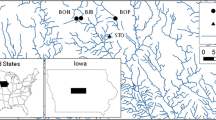Abstract
In the United States, the regulatory approach to wetland protection has a traditional focus on size as a primary criterion, with large wetlands gaining significantly more protection. Small, isolated wetlands have received less protection; however, these wetlands play a significant role in the maintenance of biodiversity of many taxonomic groups, including amphibians. An important question for directing conservation and management efforts for amphibians is whether size is a useful criterion for regulatory decisions. Because hydroperiod has an important influence on amphibian composition in wetlands, I conducted a study to examine the relative influence of wetland size and hydroperiod on amphibian occurrence. I sampled 103 wetlands in southern New Hampshire in 1998 and 1999 using dipnet sampling to document the presence of larval amphibians. Wetlands were placed into one of three hydroperiod categories; short (<4 months), intermediate (4–11 months), or long (permanent) based on field observations of drying pattern. Wetland size was determined from digitized national wetland inventory (NWI) maps (most wetlands) or measured in the field. I examined patterns of amphibian species richness and individual species occurrence using generalized linear models. Wetland size ranged from 0.01 to 3.27 ha. Overall, species richness was significantly influenced by hydroperiod (χ2 = 18.6, p <0.001), but not size (χ2 = 1.4, p = 0.24). Examination within hydroperiod categories revealed several significant relationships with wetland size. Species richness was related to wetland size in wetlands with short and intermediate hydroperiods, but not wetlands with long hydroperiods. Wetland size does not appear to be a useful sole criterion for determining wetland functional value for amphibians; assessments of functions of seasonally inundated wetlands for amphibians would benefit from examination of hydroperiod.
Similar content being viewed by others
References
R. Altig (1970) ArticleTitleA key to the tadpoles of the continental United States and Canada Herpetologica 26 180–207
K.J. Babbitt M.J Baber T.L. Tarr (2003) ArticleTitlePatterns of larval amphibian distribution along the wetland hydroperiod gradient Can. J. Zool. 81 1539–1552 Occurrence Handle10.1139/z03-131
C.A. Binckley W.J. Resitarits SuffixJr. (2003) ArticleTitleFunctional equivalence of non-lethal effects: generalized fish avoidance␣determines distribution of gray treefrog, Hyla chrysoscelislarvae Oikos 102 623–629 Occurrence Handle10.1034/j.1600-0706.2003.12483.x
A.J.K. Calhoun T.E. Walls S.S. Stockwell M. McCollough (2003) ArticleTitleEvaluating vernal pools as a basis for conservation strategies: a Maine case study Wetlands 22 70–81
J. Christie S. Hausmann (2003) ArticleTitleVarious state reactions to the SWANCC decision Wetlands 23 653–662
R.S. Egan P.W.C. Paton (2004) ArticleTitleWithin-pond parameters affecting oviposition by wood frogs and spotted salamanders Wetlands 24 1–13
ESRI inc. 1999. ArcInfo User’s Manual, Version 7.2.1. Environmental Systems Research Institute Inc. Redlands, California, USA.
J.P. Gibbs (1993) ArticleTitleImportance of small wetlands for the persistence of local populations of wetland-associated animals Wetlands 13 25–31
J.P. Gibbs (2000) ArticleTitleWetland loss and biodiversity conservation Conserv. Biol. 14 314–317 Occurrence Handle10.1046/j.1523-1739.2000.98608.x
S.J. Hecnar R.T. Mȁ9Closkey (1996) ArticleTitleRegional dynamics and the status of amphibians Ecology 77 2091–2097
M.E. Hopey J.W. Petranka (1994) ArticleTitleRestriction of wood frogs to fish-free habitats: how important is adult choice? Copeia 1994 1023–1025
J. Kaiser (1998) ArticleTitleNew wetlands proposal draws flak Science 279 980 Occurrence Handle10.1126/science.279.5353.980 Occurrence Handle1:CAS:528:DyaK1cXhtF2rtbY%3D
P. McCullagh J.A. Nelder (1989) Generalized linear models Chapman & Hall London, UK
P.E. Moler R. Franz (1987) Wildlife values of small, isolated wetlands in the southeastern coastal plain R.R. Odum K.A. Riddleberger J.C. Ozier (Eds) Proceedings of the 3rd Southeast Nongame and Endangered Wildlife Symposium Georgia Department of Natural Resources AtlantaGeorgiaUSA 234–240
G. Orton (1939) Key to New Hampshire amphibian larvae H.E. Warfel (Eds) Biological Survey of the Connecticut Watershed New Hampshire Fish and Game Department ConcordNew HampshireUSA
P.W.C. Paton W.B. Crouch III. (2002) ArticleTitleUsing the phenology of pond-breeding amphibians to develop conservation strategies Conserv. Biol. 16 194–204 Occurrence Handle10.1046/j.1523-1739.2002.00260.x
K.O. Richter A.L. Azous (1995) ArticleTitleAmphibian occurrence and wetland characteristics in the Puget Sound Basin Wetlands 15 305–312
InstitutionalAuthorNameSAS (2001) SAS/STAT software Version 8 m SAS institute Cary North CarolinaUSA
R.D. Semlitsch J.R. Bodie (1998) ArticleTitleAre small, isolated wetlands expendable? Conserv. Biol. 12 1129–1133 Occurrence Handle10.1046/j.1523-1739.1998.98166.x
R.D. Semlitsch (2000) ArticleTitlePrinciples for management of aquatic-breeding amphibians J. Wildlife Manage. 64 615–631
D.K. Skelly (1996) ArticleTitlePond drying, predators, and the distribution of Pseudacris tadpoles Copeia 1996 599–605
J.W. Snodgrass M.J. Komoroski A.L. Bryan SuffixJr. J. Burger (2000) ArticleTitleRelationships among isolated wetland sizehydroperiodand amphibian species richness: implications for wetland regulations Conserv. Biol. 14 414–419 Occurrence Handle10.1046/j.1523-1739.2000.99161.x
R.W. Tiner H.C. Bergquist G.P. DeAlessio J.L. Greene (2002) Geographically isolated wetlands: a preliminary␣assessment of their characteristics and status in selected areas of the United States U.S. Department of the InteriorFish and Wildldife Service Northeast Region Hadley, Massachusetts, USA
J. Travis (1981) ArticleTitleA key to the tadpoles of North Carolina Brimleyana 6 119–127
G.A. Wellborn D.K. Skelly E.E. Werner (1996) ArticleTitleMechanisms creating community structure across a freshwater habitat gradient Ann. Rev. Ecol. Syst. 27 337–363 Occurrence Handle10.1146/annurev.ecolsys.27.1.337
B.D. Woodward (1983) ArticleTitlePredator-prey interactions and breeding-pond use of temporary species in a desert anuran community Ecology 64 1549–1555
Author information
Authors and Affiliations
Corresponding author
Rights and permissions
About this article
Cite this article
Babbitt, K. The relative importance of wetland size and hydroperiod for amphibians in southern New Hampshire, USA. Wetlands Ecol Manage 13, 269–279 (2005). https://doi.org/10.1007/s11273-004-7521-x
Received:
Accepted:
Issue Date:
DOI: https://doi.org/10.1007/s11273-004-7521-x




